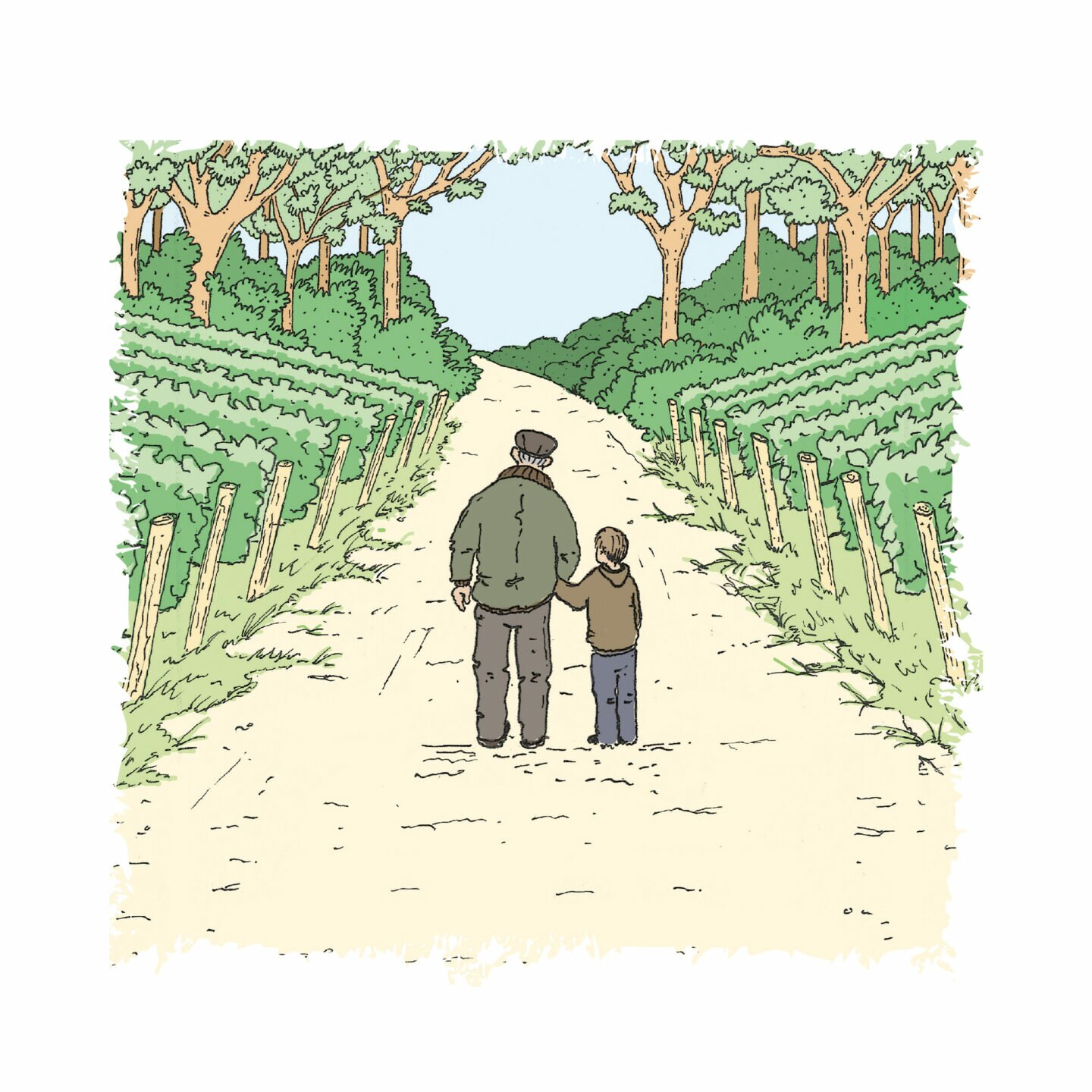Picture a silhouette of a little boy and his grandfather walking through the forest. No, this is not an image from a children’s bedtime story. It is the label of Champagne Antoine Bouvet. The eponymous winegrower took over his grandfather Guy’s 5 hectare estate in 2011 when he was just 18 years old and the label tells the story of him as a child being guided along by grandpa in the vineyards. Inspired by their relationship, 31-year-old graphic designer Quentin Maza conceptualised the label design.
Grower champagne, as a genre, is not new. Farmer fizz, as they are sometimes known, are family-owned estates scattered throughout Champagne. As opposed to Grand Marques — big brands the likes of Moët & Chandon and Veuve Clicquot — who purchase grapes to supplement their crop, growers traditionally only make wines from the grapes in their own vineyards.
The most iconic and influential grower is undoubtedly Anselme Selosse from Domaine Jacques Selosse. Since taking over in 1980, he has introduced sustainable farming, lower yields and barrel-ageing, methods which were revolutionary at the time. Since then, he has inspired an entire generation of winegrowers in Champagne. Even Grand Marques have taken a leaf out of his book.
The new wave of growers take inspiration from the natural winemaking trend sweeping across Europe and many parts of the New World. Organic and biodynamic farming are de rigueur, as are minimal intervention and low sulphur usage in the cellar. Nothing added, nothing removed is the mantra. Many of these growers are young, below 30 years old and eager to leave their mark on their creations, both inside and outside the bottle. Compared to their older peers, they face less pressure to conform to what classical champagnes should look like. This follows through on the label itself.
Cartoonish, irreverent wine labels is a fairly new trend, first deployed by the natural wine movement that oftentimes prioritises philosophy over conforming to expected profiles or appellation rules. A canvas for a winegrower to express the story of his wine, the visual statement attracts new drinkers who typically feel alienated by the formality of traditional labels.
Ronald Kamiyama, managing partner of the Cicheti Group, which stocks plenty of such wines, muses: “There can be so many emotions expressed in a picture. It brings out our customers’ curiosity to drink it more, almost as if they can relate to the label just by tasting the wine.”
Classic champagne labels, on the other hand, seem almost templated — stuffy text, almost always in a cursive font and occasionally emblazoned with the crest of the estate. One of the key defining characteristics of the grower champagne movement is that they eschew the verbose labels of the past, choosing instead to use label art to tell the story.
“The label for Antoine Bouvet was my first try at designing a champagne label. Antoine knew I was a graphic designer and he contacted me when he was ready to release his champagnes,” says Maza. Born in Epernay, the heart of Champagne, he is naturally a champagne lover.
“Many of my clients have ideas and stories which they want to express on their label and it is up to me to translate that into a picture or a design. Each time, it is a rewarding challenge,” he adds.
One of those clients is Florent Mignon. Working alongside his brother, Florent is one half of Les Freres Mignon. A fairly new estate, their family used to sell their grapes to the Grand Marques, but decided in 2016 that it was time to make their own champagne. As big fans of comics — in particular, Astérix and Obélix — it came as no surprise that their label features an illustration of the brothers in the cellar and in the vineyards.
“We want the labels to tell a story,” says Mignon. “For instance, the micro-climate of Cuis is cold, so in that label we are depicted with scarfs while snow is falling.” It is with this story that they wish to attract a new generation of drinkers.
“Aside from branding, the traditional label does not add much interest to the champagne. But from our labels, you can enjoy the wine and also imagine what goes on behind it.”
This view is also echoed by Julien Fournier, the fifth generation of Champagne Thierry Fournier. After a six-month internship in Singapore to understand the export market, he returned to his village of Festigny in Champagne to continue the family legacy.
“In the past, yields were high. But now, we can control the yields for quality and produce different cuvees which reflect the terroir better,” says Fournier. He understands that this is a trend the market is heading towards, especially in sophisticated wine-loving countries like Singapore.
The young grower has also convinced his father to redesign their label. “Our former label was quite old school with no specific identity and they were not understood by many,” he explains. The new label, also designed by Maza, is now a minimalist braid to represent both the vines and the links through the generations. He hopes this will attract new inquisitive champagne lovers eager to find out more about their story.
As a whole, however, grower champagnes still represent a small part of the overall production of champagne, making up only about 28 percent of its entire output in 2019. The lion’s share will always belong to the Grand Marques as mass-produced non-vintage champagnes are sold in every corner of the world. But with the growing trend towards small, limited-production brands that are environmentally conscious, the story of grower champagnes is thriving, especially among the younger generation. And just as a picture speaks a thousand words, growers certainly hope the story on their labels will reach a wider audience.



